Marines Delay Female Fitness Standards
The Marine Corps' plan to make women take the same fitness test as men has hit a wee snag.
The Marine Corps’ plan to make women take the same fitness test as men has hit a wee snag.
AP (“Marines Delay Female Fitness Plan After Half Fail“):
More than half of female Marines in boot camp can’t do three pullups, the minimum standard that was supposed to take effect with the new year, prompting the Marine Corps to delay the requirement, part of the process of equalizing physical standards to integrate women into combat jobs.
The delay rekindled sharp debate in the military on the question of whether women have the physical strength for some military jobs, as service branches move toward opening thousands of combat roles to them in 2016.
Although no new timetable has been set on the delayed physical requirement, Marine Corps Commandant Gen. James Amos wants training officials to “continue to gather data and ensure that female Marines are provided with the best opportunity to succeed,” Capt. Maureen Krebs, a Marine spokeswoman, said Thursday.
Starting with the new year, all female Marines were supposed to be able to do at least three pullups on their annual physical fitness test and eight for a perfect score. The requirement was tested in 2013 on female recruits at Marine Corps Recruit Depot, Parris Island, S.C., but only 45 percent of women met the minimum, Krebs said.
The Marines had hoped to institute the pullups on the belief that pullups require the muscular strength necessary to perform common military tasks such as scaling a wall, climbing up a rope or lifting and carrying heavy munitions.
Officials felt there wasn’t a medical risk to putting the new standard into effect as planned across the service, but that the risk of losing recruits and hurting retention of women already in the service was unacceptably high, she said.
The reaction is predictable:
The decision to suspend the scheduled pull-up requirement “is a clear indication” that plans to move women into direct ground combat fighting teams will not work, said Elaine Donnelly, president of the conservative Center for Military Readiness and a critic of allowing women into infantry jobs.
“When officials claim that men and women are being trained the same, they are referring to bare minimums, not maximum qualifications that most men can meet but women cannot,” Donnelly wrote in an email to The Associated Press. “Awarding gender-normed scores so that women can succeed lowers standards for all. Women will suffer more injuries and resentment they do not deserve, and men will be less prepared for the demands of direct ground combat.”
But that conflates a lot of separate issues.
It’s pretty clear that very few women are cut out for the infantry. Thus far, in tests conducted with the most highly motivated and physically fit women the Marine Corps can find, zero women have made it through infantry officer training and only a handful have made it through the enlisted course. While we’ll likely figure out ways to improve retention rates through better training—we, after all, have much more experience training infantrymen than infantrywomen—we’re never going to be able to produce female grunts in large scale without lowering standards. Everyone should be fine with that reality; we knew it going in.
Unless we lower standards, though, there’s no reason to think that the relative handful of women who complete training will present an increased danger to themselves or their squad mates. It’s the standards, not the sex of the soldiers or Marines, that matter.
It’s also rather obvious that pull-ups are harder on aggregate for women than men. News flash: we’re built differently. Pretty much any healthy male of military age can be trained in short order to do three pull-ups. I was never an athlete but was doing fifteen or more in my prime. While I’m barely able to muster one at this point, I expect to be back to at least the minimum standard in a few weeks even at the ripe old age of 48. (Indeed, while the max score requirements go down with age, three remains the male minimum even in the top, over-46 group.)
The question, though, is whether the ability to do pull-ups is a true proxy for being able to accomplish on the job tasks, or merely an easy but male-specific means of assessing upper body fitness. At Airborne school, which was long gender-integrated even back when I attended in the Stone Age, males had to do some significant number of pull-ups; I seem to recall it being eight but I could be off a bit. The justification was that this was necessary because a trooper needed to be able to pull up on his risers to control the chute in the air. The women, however, didn’t have to do pull-ups at all. As it turned out, though, they were no less able to safely operate a parachute than we were. [Although, as a commenter points out, extremely lightweight soldiers—a category mostly filled by women—have issues being blown around exiting the aircraft.]
So, the bottom line is that the focus should be on figuring out what standards are required to perform the required duties of a given military occupational specialty—as well as to simply serve in combat, where even service support specialists can sometimes be called on to perform infantry-type duties on a limited basis—and then to train to and enforce those standards. If that results in very few women being able to serve in specialties that are glamorous and career-enhancing, that’s too damn bad. But we shouldn’t deny fully capable soldiers and Marines the ability to serve simply on the basis of arbitrary, even if long-standing, litmus tests.
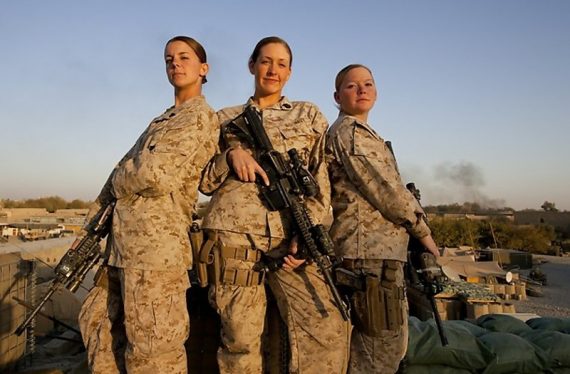

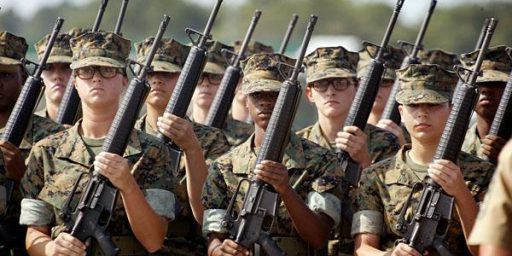
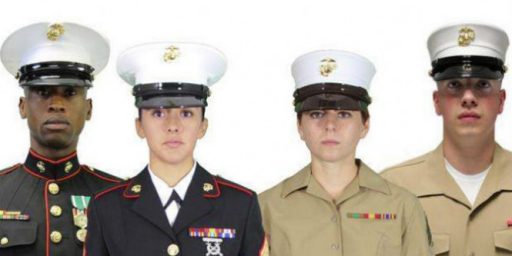
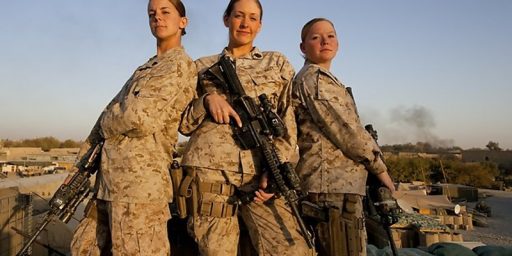
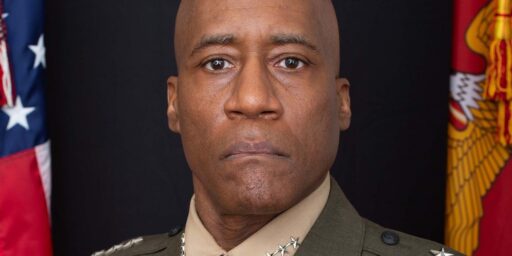
Gunnery Sgt. Hartman is saying, “I guess the Corps don’t get theirs.”
@James Pearce: Ha!
James Joyner,
If it’s that important to the Corps they can put women into weight training until the minimum can be met, but as you’ve pointed out, what reason is there to do so if it won’t really affect their combat performance? It’s possible that high upper body strength is important for the role, but it’s also possible an organization as conservative as the U.S. Marine Corps is just struggling to change.
My, personal experience is that strength is generally useful for moving heavy equipment or munitions around, not a whole lot else.
to play like the boys you train like the boys. these aren’t cops we’re talking about.
Yeah, that’s not really difficult. You’re not really pulling yourself up, anyway–you’re pulling that side of the canopy down so air spills out the other side.
Or if you’re lucky like me you get to jump steerable rounds all the time. Just pull on the toggle until you’re facing into the wind, easy peasy.
We had a little tiny woman in my Airborne school class–she was tough, but just so tiny. One time she attempted to exit the aircraft and got blown back in. It was kind of funny, albeit a bit dangerous (fortunately the JM had control of her static line). She’d be the second out of the aircraft and the last to land.
Ah, memories…
@Ben Wolf: And pull-ups aren’t just about strength. I’m not as strong as I was 25 years ago, of course, but I can still lift heavy objects and carry them short distances. Pull-ups are a very specific test of strength and endurance.
@Mikey: Yup. In 1989, when I went, we mostly jumped the old T-10 Charlies but I jumped once with the -1 Bravo toggled ‘chute.
@Mikey: @James Joyner: I wish I had joined the military. I took the ASVAB and endured the physical, but then this little Navy guy in a (deleted) white uniform* started barking at us and they told me I’d have to wear BCGs. I said, “F this,” and never talked to the recruiter again.
Movies, man….that’s my only military experience.
* Also a movie reference, edited for television.
And that is why it is important in infantry. The only mule you get is your own a$$.
The sad thing is that real research won’t be permitted. We have the technology to compare the internals to minute detail to see who can and can’t do pull-ups and possibly find more effective ways of training. But I doubt any one in the DoD wants to risk having physiological proof that men and women are built different and it’s not something that can be trained out. The gender assault troops would pour into the breach. Same goes with comparing the musculature of those women who can meet the standard with those who can’t.
So females can’t serve as front line infantry ( add in tanks and artillery). The vast majority of people in the Marines and the Army aren’t front line infantry. Plenty of other ways women can serve in the Marines.
I seem to remember that the women who fought for North Viet Nam against our forces were pretty effective. Any thoughts from ‘Nam vets?
@JKB: One of the things I’ve come to respect is James’ ability to zero in on what’s pertinent. Pull-ups test solely the strength in your biceps, shoulders and upper back. Carrying equipment on your back or in your arms uses core muscles and legs as well; women can carry nearly as much as men under such conditions if they’re in excellent condition. Maybe not a hundred pounds, but close.
Woman does 10 pull-ups.
Woman does 20 pull-ups.
Woman does 39 pull-ups. http://www.youtube.com/watch?v=YtqW2SYYxP0
YouTube is full of them. And they all sure look like girls.
@anjin-san:
Greetings, anjin-san: ( @ Friday, January 3, 2014 at 11:52 )
You weren’t thinking of Jane Fonda, now, were you ???
Can women fight in wars?
@JKB: What we’re asking is whether the test of a pull-up actually tests anything that soldiers need to have as an essential skill.
Otherwise, it’s just one of those hoops that you males have invented so you can pat yourself on your back and tell each other how much superior you are to us females. We’ve seen a lot of that. Arguments about PMS, wandering wombs, feeble brains, etc. Obviously why we females should be barred from particular jobs (law or medicine, for example), not allowed to vote, own our own money, have our own credit, etc.
Shall we say that given the putrid track record such “tests” have had in history those of us of the feminine persuasion may be a wee bit skeptical…..
@grumpy realist:
There aren’t a lot of pull-ups going on in day-to-day military duty–as James points out, they’re in the PT test as a proxy for other things. I think the pertinent question is “for what do pull-ups proxy?” And the follow-on, once that’s determined, is “is there a better way to test for that?”
@ 11B40
Still searching for an original thought I see…
@michael reynolds:
Greetings, michael reynolds: ( @ Friday, January 3, 2014 at 12:23 )
If you will allow me to skip my usual preliminaries, my thinking is a tad different from yours. The “can” is an important criterion but there’s also the “should”. Farmers “can” eat their seed corn but don’t. That would be because of the “should”.
Another analytic I would offer is this. The question more pertinent even than the “can” is can they do the job so well as to make up for all the distractions and accommodations their presence will engender. Without going into the aestetics of Russian or Slavic women, my management philosophy includes distraction reduction as a usually good thing. (But there’s certainly a counter-argument to this in “Why should DADT infantrymen get all the sexual opportunities ?).
The hollowing out of our military has been going on in some form or other since the military draft was suspended back in ’73. In that light, infantrypersons are just the salami slice ju jour (or should that be di giorno ?). To “social justice” zealots everything is a “social justice” problem. You can bet that our Muslimaniac brethren won’t be throwing down any scimitars when the ladies start showing up. And the former have an interesting bit of philosophy about how to deal with captured womenfolk, much more Green Crescent than Red Cross, if you get my drift.
And being a bit of a Russophile myself, I would just add this. “Social justice” was what Lenin and Stalin bequeathed to Russia and eastern Europe, no ???
@11B40:
Sadly, drift is all you ever offer. I’m hoping you’re really, really old. Because otherwise you’re just really, really dumb.
@michael reynolds: Which is why I’m always careful in making the generalizations about the aggregate. Indeed, my whole point is that while MOST women can’t meet the standards, SOME can.
@11B40:
Dude, WTF was that? What was that word salad even about?
Based on all the posts, it seems that it would be-
1. Possible for the Marines to design more inclusive tests.
2. Possible to train women to do that 3 pull-up minimum
I think what may be the problem might be a simple lack of will to make it happen.
@James Joyner:
I agree. No lowering of standards. Re-examine standards that may be silly or beside the point. But in the end women have to be able to operate at the same level as a man or too damn bad.
I would bet there are many NFL lineman who can lift a lot but can’t do pullups.
If you want to test if they could climb a rope, scale a wall or lift heavy munitions how about having them actually perform these tasks instead of
Substitutes like pullups. It’s like asking the women to pee four feet up a wall to test their ability to gauge distance.
The heart of the issue is standards and the proxies used to measure standards. For a very long time physical fitness tests consisted of basic, repetitive exercises that are easily measured and could be performed anywhere. For a very long time, the inherent limitations of those simplistic standards have weeded out people who are very fit or capable but otherwise could not adequately peform some aspect of the test. In my 21 years of total military service I have seen many very fit people break from their normal workouts in order to train to the PF test which improved their scores. They didn’t suddenly become more fit because they trained to the tested standard.
As another example, in the Air Force, if a male of any age measures greater than 39 inches around the gut level with the belly button, that person automatically fails their PF test. The Air Force did a study on this because of many complaints and it turns out that there are several thousand people in the service who can pass all the other parts of the test except for the waist measurement. DoD requires the services to use body fat/composition as part of PF tests and this is how one service measures that. Obviously it is far from perfect.
The point in all this is that the military needs to measure physical fitness, and it needs a method that is easily measurable and can be peformed without special equipment. If pull-ups are a bad measurement that is biased toward males in determining job performance for the infantry, then we need some evidence to support that as well as an alternative standard of performance.
@beth: The infantry courses do that. I haven’t done the research, so I wonder why women aren’t passing. If they can do everything except some arbitrary number of pullups, that would be an indicator that pullups are a bad proxy.
@michael reynolds: Amusingly, that’s a perfect summary of my original post.
@Andy: @beth: Well, in fairness, I’m guessing the women who passed the infantry course could do three pull-ups if not well more than that. The issue is whether to extend the three pull-up minimum to all female Marines, regardless of MOS.
@Andy: I’m also surprised because there are quite a few weight-lifting programs for women that can train for the pull-up.
I’m working on them myself. Goal is ten pull-ups in perfect form. I realize it’s going to take me a year or so to get to that level, but if I can train towards that as a desk slug, I don’t see why women wanting to get into the Marines can’t train as well. (It’s actually more back muscles than arm muscles, although for most women the weakness of the arm muscles provides the limiting factor.)
@Mike:
Actually I doubt there’s a single NFL lineman who can’t do three pullups. Seriously, its a very low hurdle, and I see women doing it all the time in the gym.
And pullups are a great indicator of upper body strength, as well as being a great way to train it. Its why they’re one of the basic exercises in judo and wrestling weight training (and I’ve seen 300 pound competition judoka reel off ten pullups – and 170 pound women judoka do the same).
I think it says more about our societal standard of fitness than anything else that three pullups is an issue.
I agree with James’s post.
Years ago there was debate on women firefighters. The way I see it, any firefighter should be able to dead-lift off the floor a 180lb adult, while in full gear, and be able to carry them to safety. If not, they should not be in the job. I know former firemen in their 60s who are very fit who retired years ago when they could not meet that test.
Is there the equivalent task in the military?
@James Joyner:
I live to summarize.
“Every Marine a Rifleman” is one of the codes I remember.
As long as Marines are required to qualify each year, regardless of their MOS, they should have to pass a standardized PRT.
In combat, gender doesn’t matter, only performance.
@Fausta – yes, it’s called a fireman’s carry to get your wounded comrade off the field of battle and to medical help. I sure don’t want a Marine, male or female, having to fret about getting help to pull my butt out of a hot zone because they lack the strength to do so.
I say this as a retired Navy Corpsman who served with the Fleet Marine Force in combat.
Take a look around an army or marine base. There are plenty of fatties and folks out of shape. Then again I am not sure how many are infantry types
As usual, James (whom Michael ably summarizes) has the right of it.
I think there are a number of factors of which we’re losing sight:
1. the Marines are supposed to be an elite force. If you lower the standards, you should change the mission, too.
2. the underlying reason for allowing women in combat is not some abstract notion of equality between the sexes but that path to being a higher flag officer goes through combat. Maybe that shouldn’t be the case. I don’t think so—I think we should have a lot fewer flag officers and all of them should have combat experience.
It wasn’t so much that there weren’t women who could pass they just weren’t passing in large numbers.
I am not convinced pull ups are a good measure of the kind of strength needed for the infantry. I have a friend who is in her late fifties and runs a horse barn-she can still toss hay bales and shovel waste like its nothing. I have no idea if she can do pull ups, but I imagine her fitness and strength wouldn’t compromise men in the infantry. Yes it’s anecdotal. But reading this brought her to mind-she probably could outwork a lot of men and not break a sweat.
I think figuring out standards that best indicate a woman can do the job make the most sense-if three pull ups don’t correlate to success in the demands of the job they shouldn’t be a standard for men or women.
The reality is that some women aren’t going to be able to do the job just as some men can’t do certain jobs (not every man who enters special forces training meets the physical or mental standards but nobody seems to think it horrible if/when they wash out).
Standards should correlate to success in the job-I also don’t think it is the end of the world if some women can’t meet them-the military isn’t a jobs program. I would rather see the military run some studies to figure out how the standards correlate to the demands of the job for both men and women and set new ones accordingly but they also should lower those standards at the risk of the mission just to make sure women are passing at a higher than 50% rate.